An Improved Method of an Image Mosaic of a Tea Garden and Tea Tree Target Extraction
Abstract
:1. Introduction
2. Materials and Methods
2.1. Data Collection
2.2. Image Preprocessing
2.2.1. Image Denoising
2.2.2. Distortion Correction
2.3. Image Registration Based on Feature Point Extraction
2.3.1. Feature Point Extraction
- (1)
- Construct a Gaussian difference pyramid.
- (2)
- Locating and screening key points.
- (3)
- Build feature descriptors.
2.3.2. Feature Point Matching
- (1)
- Four pairs of point pairs are randomly selected from the coarse matching feature point pairs. Any three pairs are not collinear. The parameters, namely the matrix of the transformation model, are calculated by the least square method.
- (2)
- Put all the matching point pairs into the model. Calculate the point after the transformation of the Euclidean distance in each group. Set a threshold value of the delta. If the current point to calculate the Euclidean distance is less than the threshold, the current point for the model is within a set of points. Then, their point number is recorded. If it is greater than the threshold, it is eliminated.
- (3)
- Repeat steps (1) and (2) to calculate the number of interior points of the model for comparison each time. Retain the model with the most interior points.
- (4)
- In the repeated iterative calculation, when the number of the interior points reaches a certain number, the model with the largest interior points is taken as the result, or when the number of iterations reaches a certain number, the current model with the largest interior points is also output as the result.
2.3.3. Model Estimation
- (1)
- Local matrix calculation.
- (2)
- Linearization of the homograph matrix.
- (3)
- Global similarity transformation.
- (4)
- Integration of global similarity transformation.
2.4. Image Fusion Based on Improved Suture
2.5. Tea Tree Extraction
2.5.1. Vegetation Index
2.5.2. Image Features
2.5.3. Mean Shift Clustering
- (1)
- Randomly select a clustering point as the center, a sliding window with radius r, and calculate the highest point of data density in the current window as the new center.
- (2)
- Sliding the window to the new center and recalculating the cycle iteratively moves toward the direction of a higher density.
- (3)
- Convergence when there is no higher density in any direction.
- (4)
- The generated multiple clustering points are moved and converged in accordance with the above steps. When multiple centers converge and overlap, the points through which they pass are grouped into a class.
2.5.4. Tea Tree Identification
2.6. Results Evaluation
3. Results and Discussion
3.1. Tea Garden Image Registration
3.2. Tea Garden Image Fusion
3.3. Tea Tree Extraction
3.3.1. Vegetation Index
3.3.2. Tea Tree Identification
4. Conclusions
Supplementary Materials
Author Contributions
Funding
Institutional Review Board Statement
Informed Consent Statement
Data Availability Statement
Acknowledgments
Conflicts of Interest
References
- Li, X.; Feng, R.; Guan, X.; Shen, H.; Zhang, L. Remote Sensing Image Mosaicking: Achievements and Challenges. IEEE Geosci. Remote Sens. Mag. 2019, 7, 8–22. [Google Scholar] [CrossRef]
- Zhang, H.; Wang, L.; Tian, T.; Yin, J. A Review of Unmanned Aerial Vehicle Low-Altitude Remote Sensing (UAV-LARS) Use in Agricultural Monitoring in China. Remote Sens. 2021, 13, 1221. [Google Scholar] [CrossRef]
- Murugan, D.; Garg, A.; Singh, D. Development of an Adaptive Approach for Precision Agriculture Monitoring with Drone and Satellite Data. IEEE J. Sel. Top. Appl. Earth Obs. Remote Sens. 2017, 10, 5322–5328. [Google Scholar] [CrossRef]
- Pandey, A.; Pati, U.C. Image mosaicing: A deeper insight. Image Vis. Comput. 2019, 89, 236–257. [Google Scholar] [CrossRef]
- Xie, R.; Tu, J.; Yao, J.; Xia, M.; Li, S. A robust projection plane selection strategy for UAV image stitching. Int. J. Remote Sens. 2019, 40, 3118–3138. [Google Scholar] [CrossRef]
- Wang, Z.; Yang, Z. Review on image-stitching techniques. Multimedia Syst. 2020, 26, 413–430. [Google Scholar] [CrossRef]
- Keller, Y.; Averbuch, A.; Israeli, M. Pseudo-Polar Based Estimation of Large Translations Rotations and Scalings in Images. IEEE Trans. Image Processing 2005, 2, 201–206. [Google Scholar] [CrossRef]
- Kuglin, C.D.; Hines, D.A. The phase correlation image alignment method. IEEE Int. Conf. Cybern. Soc. 1975, 163–165. [Google Scholar]
- De Castro, E.; Morandi, C. Registration of Translated and Rotated Images Using Finite Fourier Transforms. IEEE Trans. Pattern Anal. Mach. Intell. 1987, 9, 700–703. [Google Scholar] [CrossRef]
- Yang, L.; Jw, A.; Ky, A. Modified phase correlation algorithm for image registration based on pyramid. Alex. Eng. J. 2022, 61, 709–718. [Google Scholar]
- Zitová, B.; Flusser, J. Image registration methods: A survey. Image Vis. Comput. 2003, 21, 977–1000. [Google Scholar] [CrossRef] [Green Version]
- Zhang, L.; Wang, L.; Yang, B.; Niu, S.; Han, Y.; Oh, S.K. Rapid Construction of 4D High-Quality Microstructural Image for Cement Hydration Using Partial Information Registration. Pattern Recognit. 2022, 124, 108471. [Google Scholar] [CrossRef]
- Copik, M.; Grosser, T.; Hoefler, T.; Bientinesi, P.; Berkels, B. Work-Stealing Prefix Scan: Addressing Load Imbalance in Large-Scale Image Registration. IEEE Trans. Parallel Distrib. Syst. 2021, 33, 523–535. [Google Scholar] [CrossRef]
- Jing, R.; Deng, L.; Zhao, W.J.; Gong, Z.N. Object-oriented aquatic vegetation extracting approach based on visible vegetation indices. J. Appl. Ecol. 2016, 27, 1427–1436. [Google Scholar]
- Gitelson, A.A.; Viña, A.; Ciganda, V.; Rundquist, D.C.; Arkebauer, T.J. Remote estimation of canopy chlorophyll content in crops. Geophys. Res. Lett. 2005, 32, L08403. [Google Scholar] [CrossRef] [Green Version]
- Ciganda, V.S.; Gitelson, A.A.; Schepers, J. How deep does a remote sensor sense? Expression of chlorophyll content in a maize canopy. Remote Sens. Environ. 2012, 126, 240–247. [Google Scholar] [CrossRef]
- Torres-Sánchez, J.; Peña, J.M.; de Castro, A.I.; López-Granados, F. Multi-temporal mapping of the vegetation fraction in early-season wheat fields using images from UAV. Comput. Electron. Agric. 2014, 103, 104–113. [Google Scholar] [CrossRef]
- Meyer, G.E.; Neto, J.C. Verification of color vegetation indices for automated crop imaging applications. Comput. Electron. Agric. 2008, 63, 282–293. [Google Scholar] [CrossRef]
- Torres-Sánchez, J.; Lopez-Granados, F.; De Castro, A.I.; Peña-Barragan, J.M. Configuration and Specifications of an Unmanned Aerial Vehicle (UAV) for Early Site Specific Weed Management. PLoS ONE 2013, 8, e58210. [Google Scholar] [CrossRef] [Green Version]
- Rasmussen, J.; Nielsen, J.; Garciaruiz, F.; Christensen, S.; Streibig, J.C. Potential uses of small unmanned aircraft systems (UAS) in weed research. Weed Res. 2013, 53, 242–248. [Google Scholar] [CrossRef]
- An, L.; Guo, B.-L.; He, W.-P.; Hou, J. A Method of Point Cloud Classification Using Multi-scale Dimensionality Features and Transductive Learning. DEStech Transactions on Computer Science and Engineering. In Proceedings of the 2018 International Conference on Computational Modeling, Simulation and Mathematical Statistics (CMSMS2018), Xi’an, China, 24–25 June 2018. [Google Scholar]
- Huang, H.; Brenner, C.; Sester, M. A generative statistical approach to automatic 3D building roof reconstruction from laser scanning data. ISPRS J. Photogramm. Remote Sens. 2013, 79, 29–43. [Google Scholar] [CrossRef]
- Wang, L.; Liu, J.; Yang, L.; Chen, Z.; Wang, X.; Ouyang, B. Applications of unmanned aerial vehicle images on agricultural remote sensing monitoring. Trans. Chin. Soc. Agric. Eng. 2013, 29, 136–145. [Google Scholar]
- Luo, D.; Gao, Y.; Wang, Y.; Shi, Y.; Chen, S.; Ding, Z.; Fan, K. Using UAV image data to monitor the effects of different nitrogen application rates on tea quality. J. Sci. Food Agric. 2021, 102, 1540–1549. [Google Scholar] [CrossRef] [PubMed]
- Jamil, A.; Bayram, B. Tree Species Extraction and Land Use/Cover Classification from High-Resolution Digital Orthophoto Maps. IEEE J. Sel. Top. Appl. Earth Obs. Remote Sens. 2017, 11, 89–94. [Google Scholar] [CrossRef]
- Lowe, D.G. Distinctive Image Features from Scale-Invariant Keypoints. Int. J. Comput. Vis. 2004, 60, 91–110. [Google Scholar] [CrossRef]
- Yuan, Y.; Fang, F.; Zhang, G. Superpixel-Based Seamless Image Stitching for UAV Images. IEEE Trans. Geosci. Remote Sens. 2021, 59, 1565–1576. [Google Scholar] [CrossRef]
- Lin, C.-C.; Pankanti, S.U.; Ramamurthy, K.N.; Aravkin, A.Y. Adaptive as-natural-as-possible image stitching. In Proceedings of the IEEE Conference on Computer Vision and Pattern Recognition (CVPR), Boston, MA, USA, 7–10 June 2015; pp. 1155–1163. [Google Scholar] [CrossRef] [Green Version]
- Burt, P.J.; Adelson, E.H. A multiresolution spline with application to image mosaics. ACM Trans. Graph. 1983, 2, 217–236. [Google Scholar] [CrossRef]
- Li, J.; Du, J. Study on panoramic image stitching algorithm. Circuits Commun. Syst. 2010, 1, 417–420. [Google Scholar] [CrossRef]
- Zaragoza, J.; Chin, T.J.; Brown, M.S.; Suter, D. As-Projective-As-Possible Image Stitching with Moving DLT. In Proceedings of the IEEE Conference on Computer Vision and Pattern Recognition (CVPR), Portland, OR, USA, 23–29 June 2013; pp. 2339–2346. [Google Scholar]
- Li, L.; Yao, J.; Xie, R.; Xia, M.; Xiang, B. Superpixel-based optimal seamline detection via graph cuts for panoramic images. In Proceedings of the 2016 IEEE International Conference on Information and Automation (ICIA), Ningbo, China, 1–3 August 2016; pp. 1484–1489. [Google Scholar] [CrossRef]
- Joo, K.; Kim, N.; Oh, T.-H.; Kweon, I.S. Line meets as-projective-as-possible image stitching with moving DLT. In Proceedings of the 2015 IEEE International Conference on Image Processing (ICIP), Quebec City, QC, Canada, 27–30 September 2015; pp. 1175–1179. [Google Scholar] [CrossRef]
- Boykov, Y.; Veksler, O.; Zabih, R. Fast approximate energy minimization via graph cuts. IEEE Trans. Pattern Analysis Mach. Intell. 2001, 23, 1222–1239. [Google Scholar] [CrossRef] [Green Version]
- Yuan, T. Optimal Seam Based Image Stitching with Large Parallax; East China Normal University: Shanghai, China, 2020. [Google Scholar]
- Lu, J.; Zhou, M.; Gao, Y.; Jiang, H. Using hyperspectral imaging to discriminate yellow leaf curl disease in tomato leaves. Precis. Agric. 2018, 19, 379–394. [Google Scholar] [CrossRef]
- Wang, X.; Wang, M.; Wang, S.; Wu, Y. Extraction of vegetation information from visible unmanned aerial vehicle images. Trans. Chin. Soc. Agric. Eng. 2015, 31, 152–159. [Google Scholar]
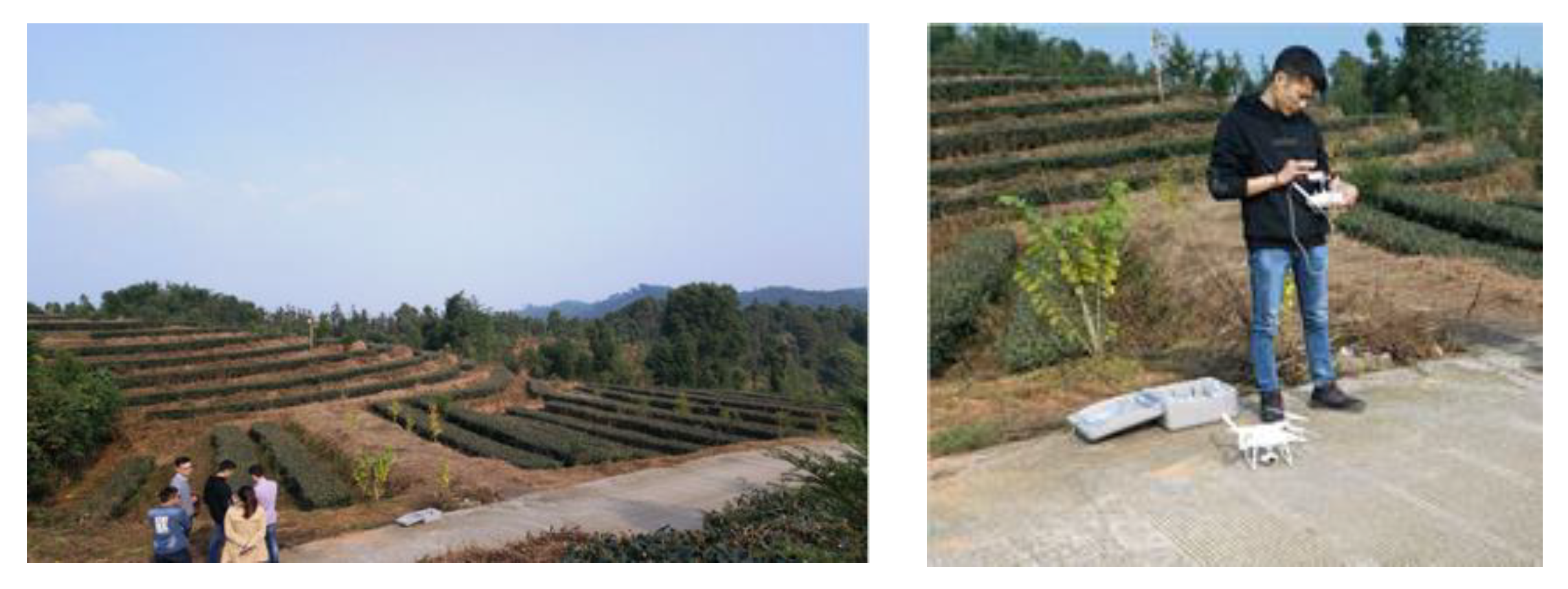
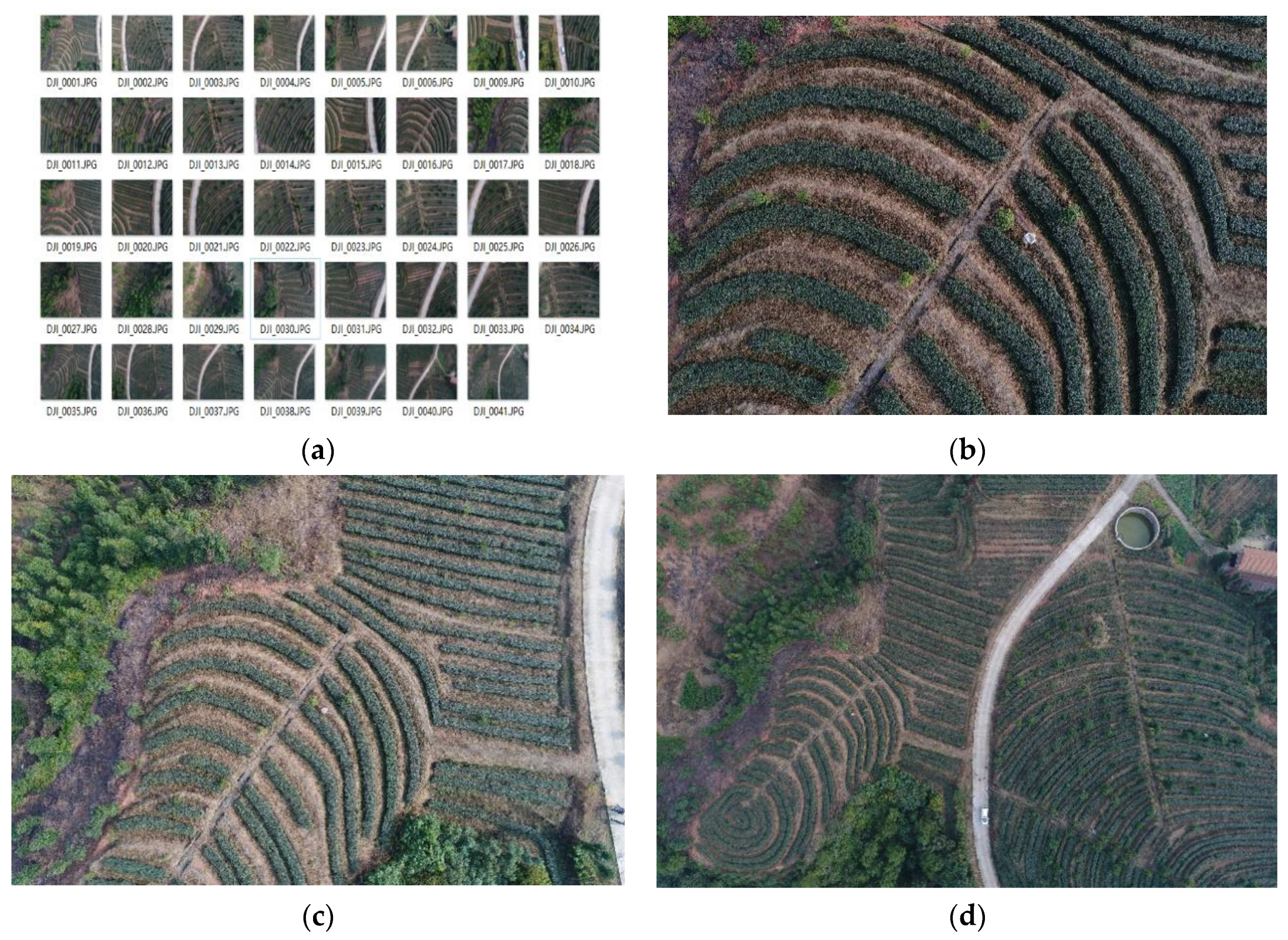
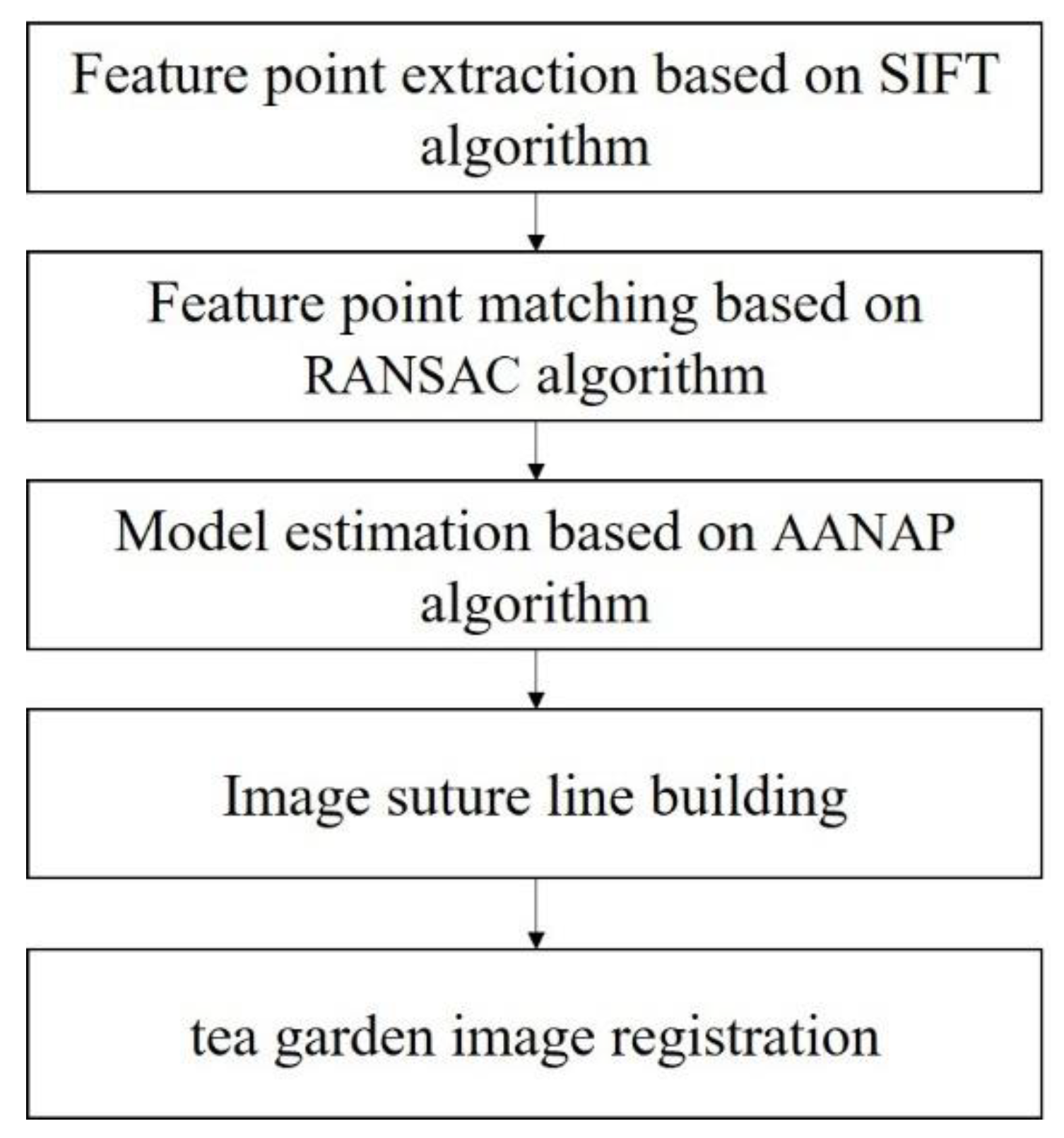
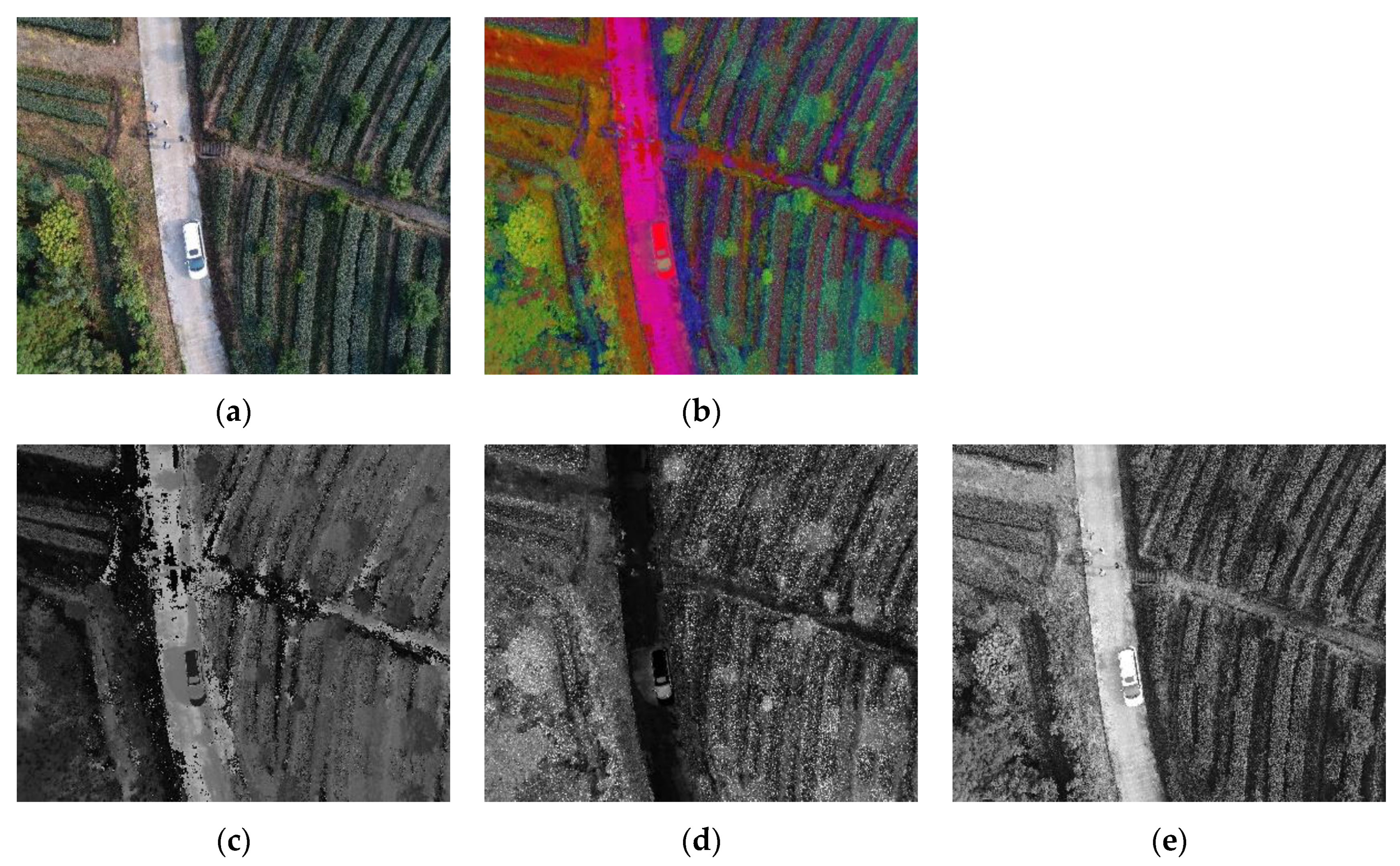
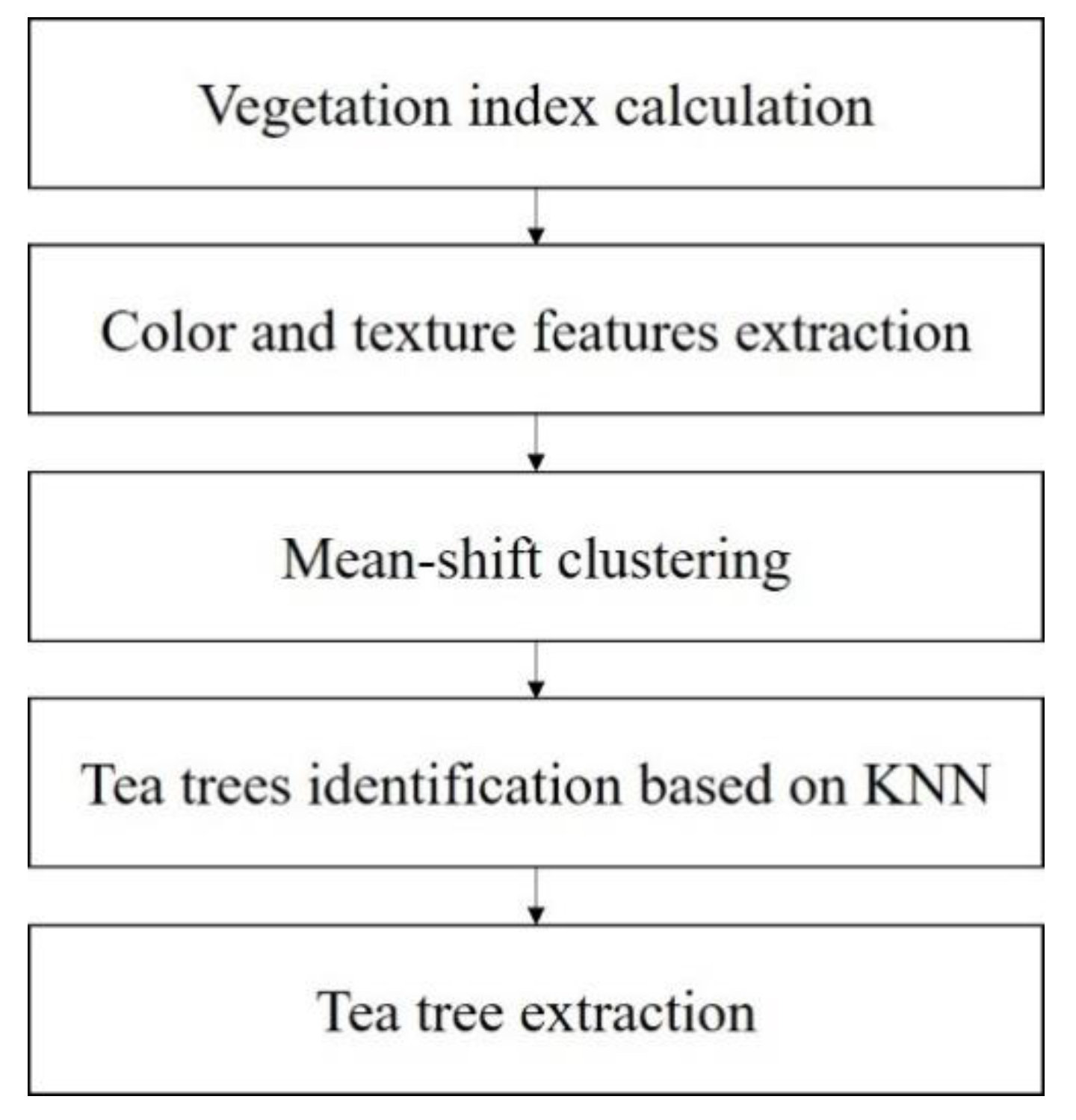
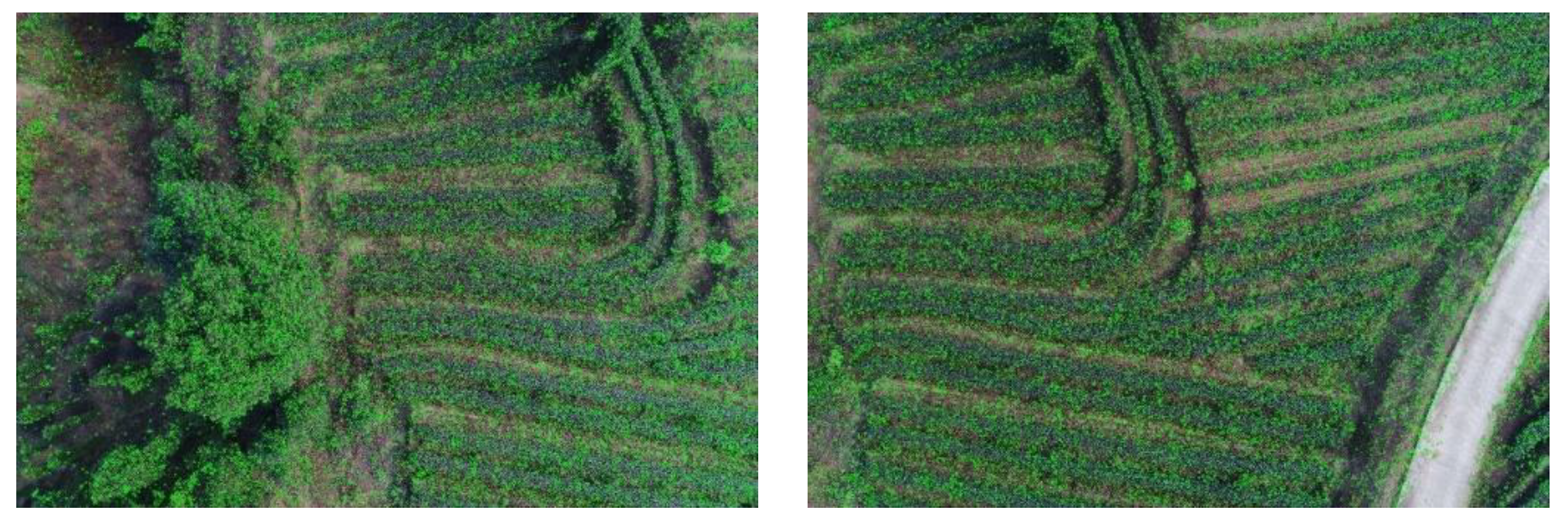
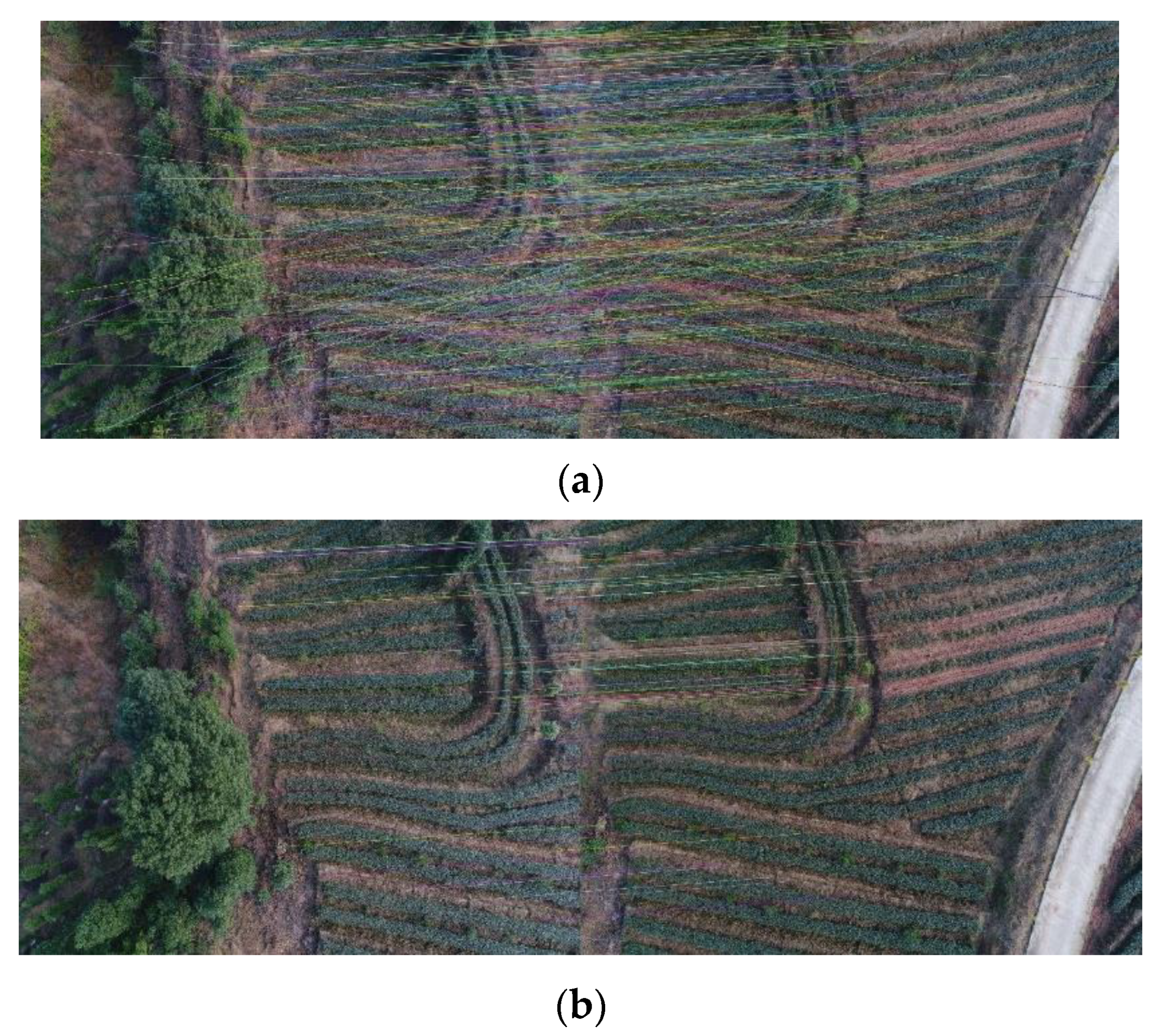
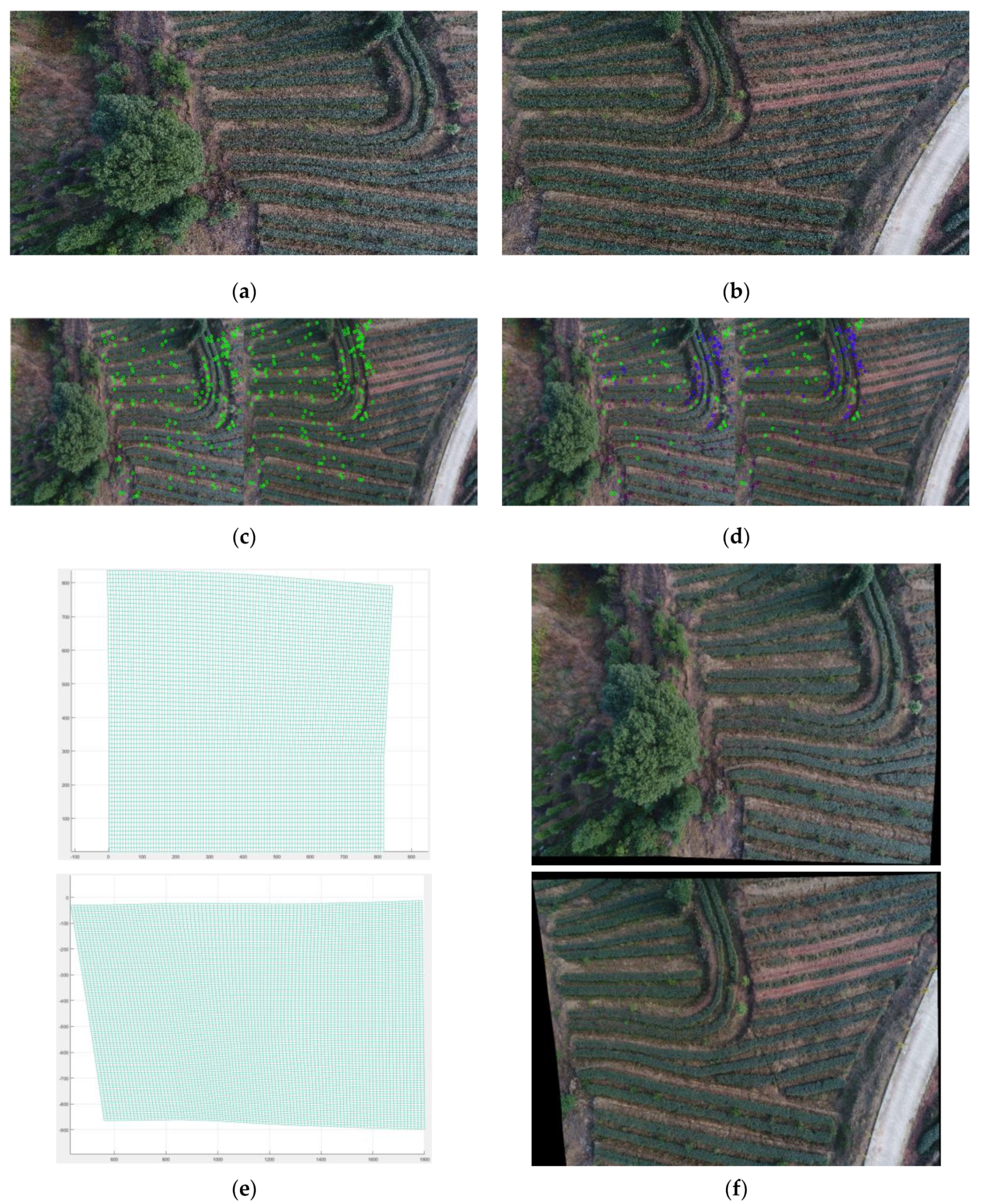




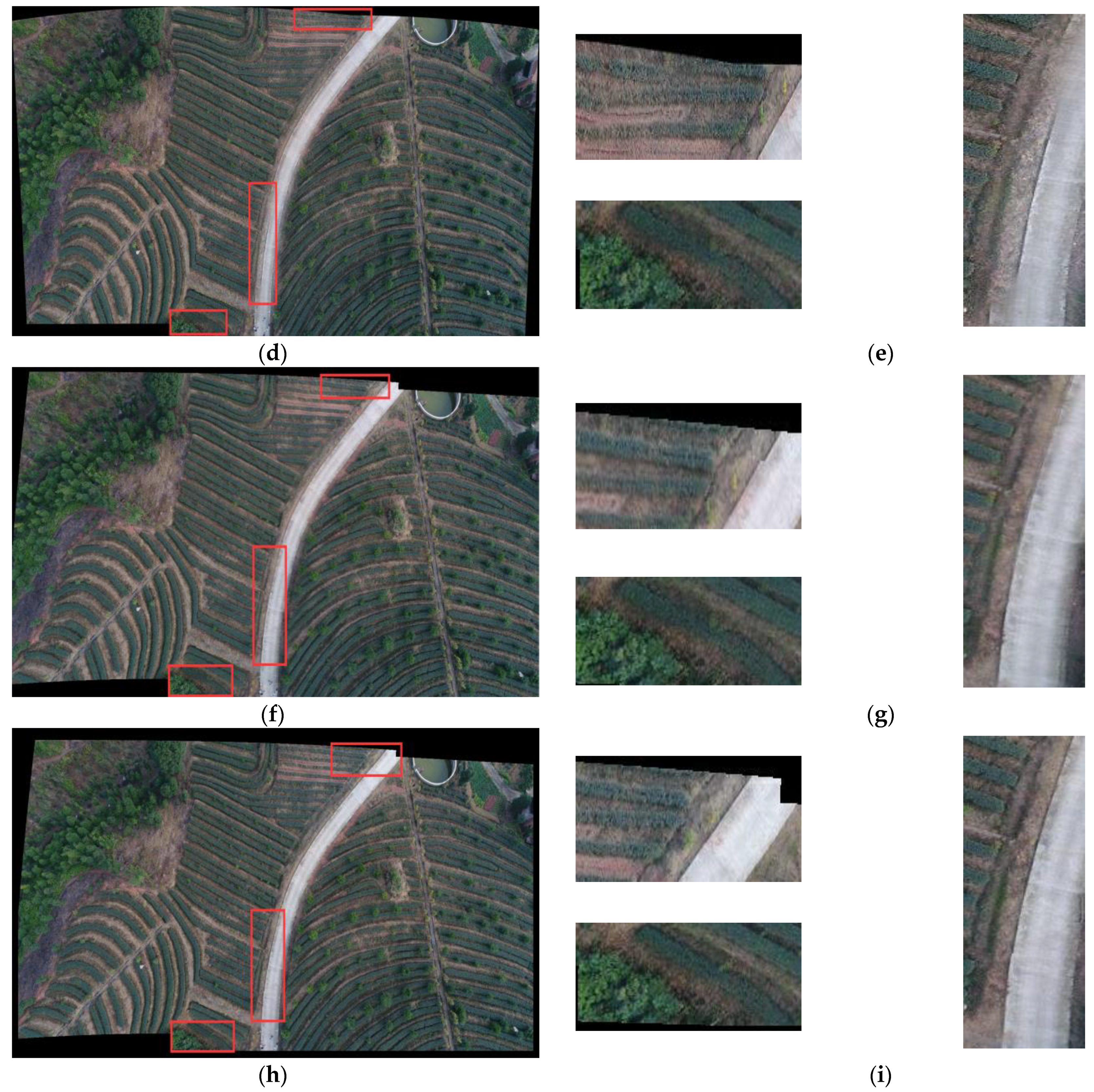
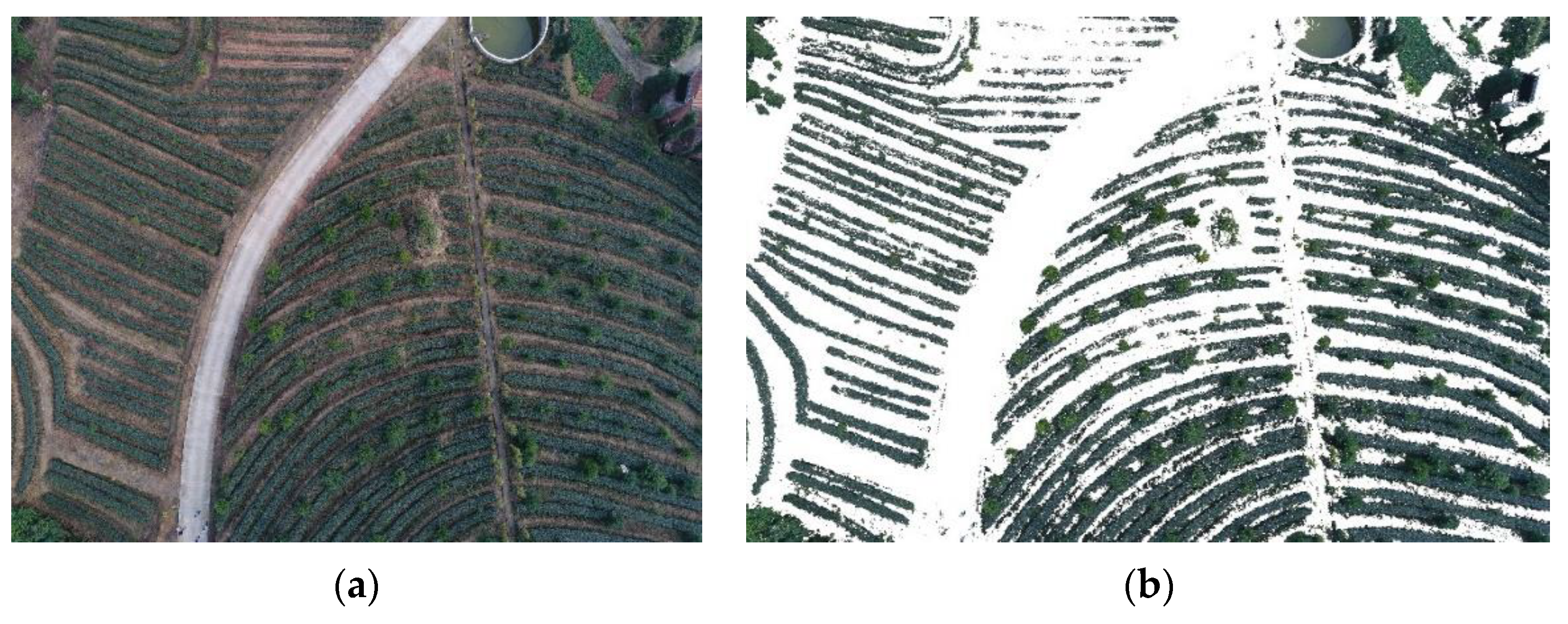
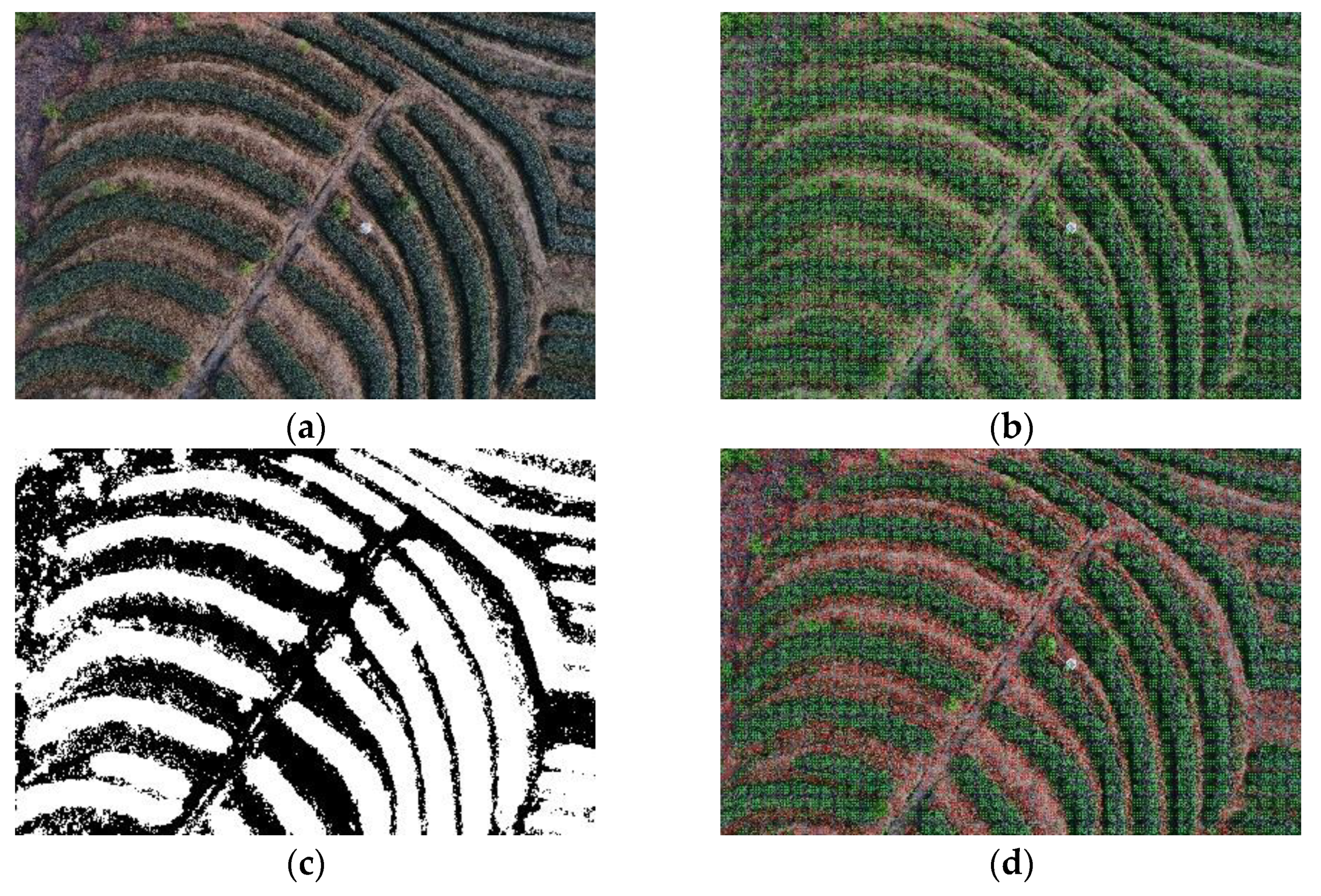
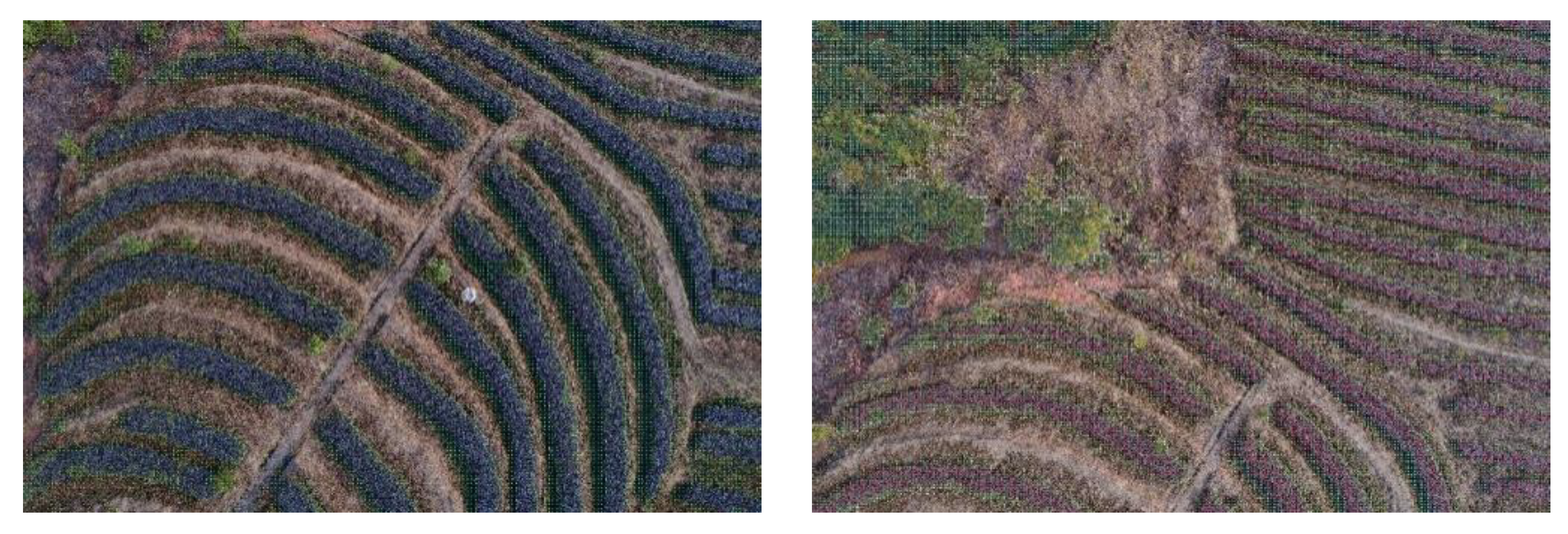
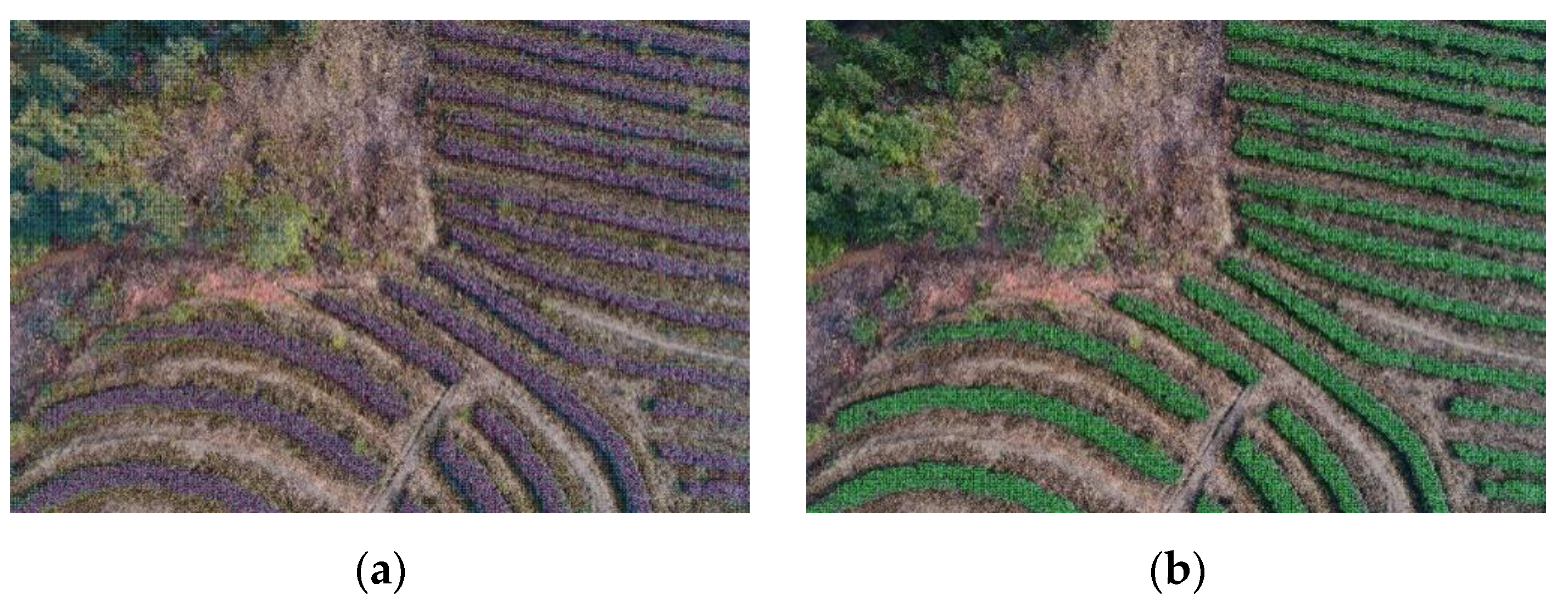
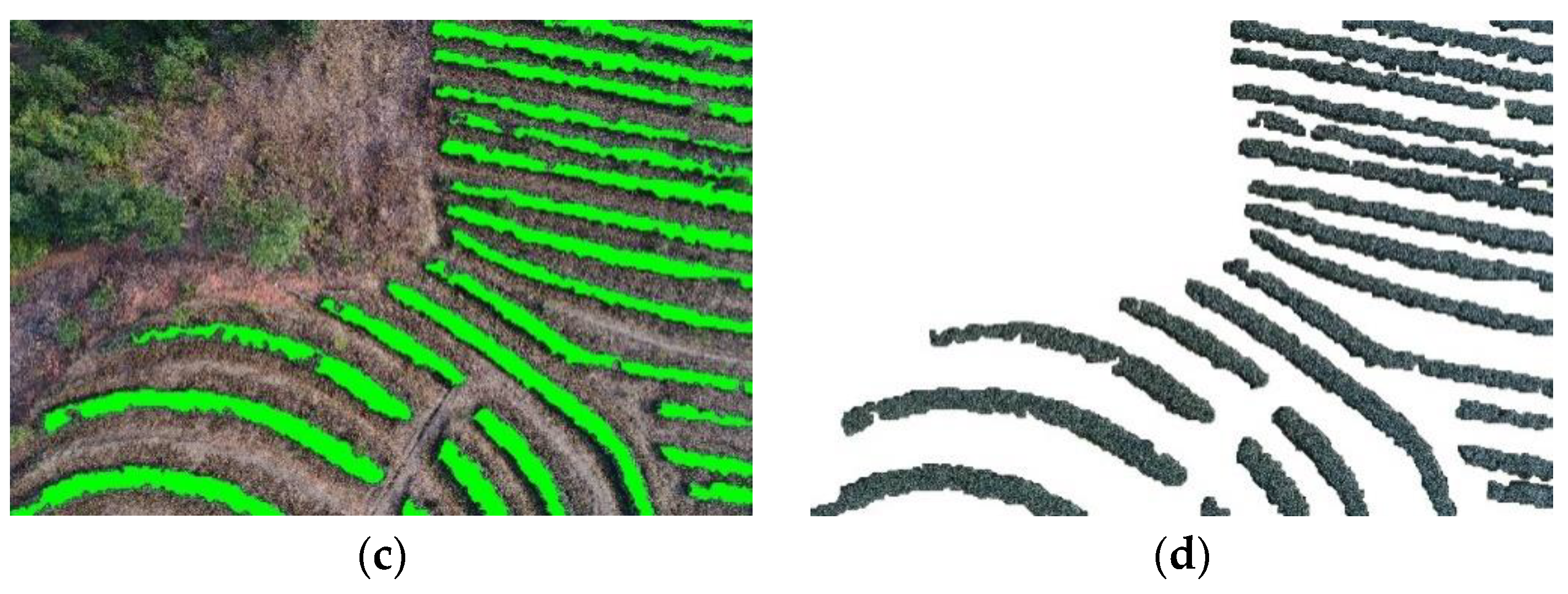

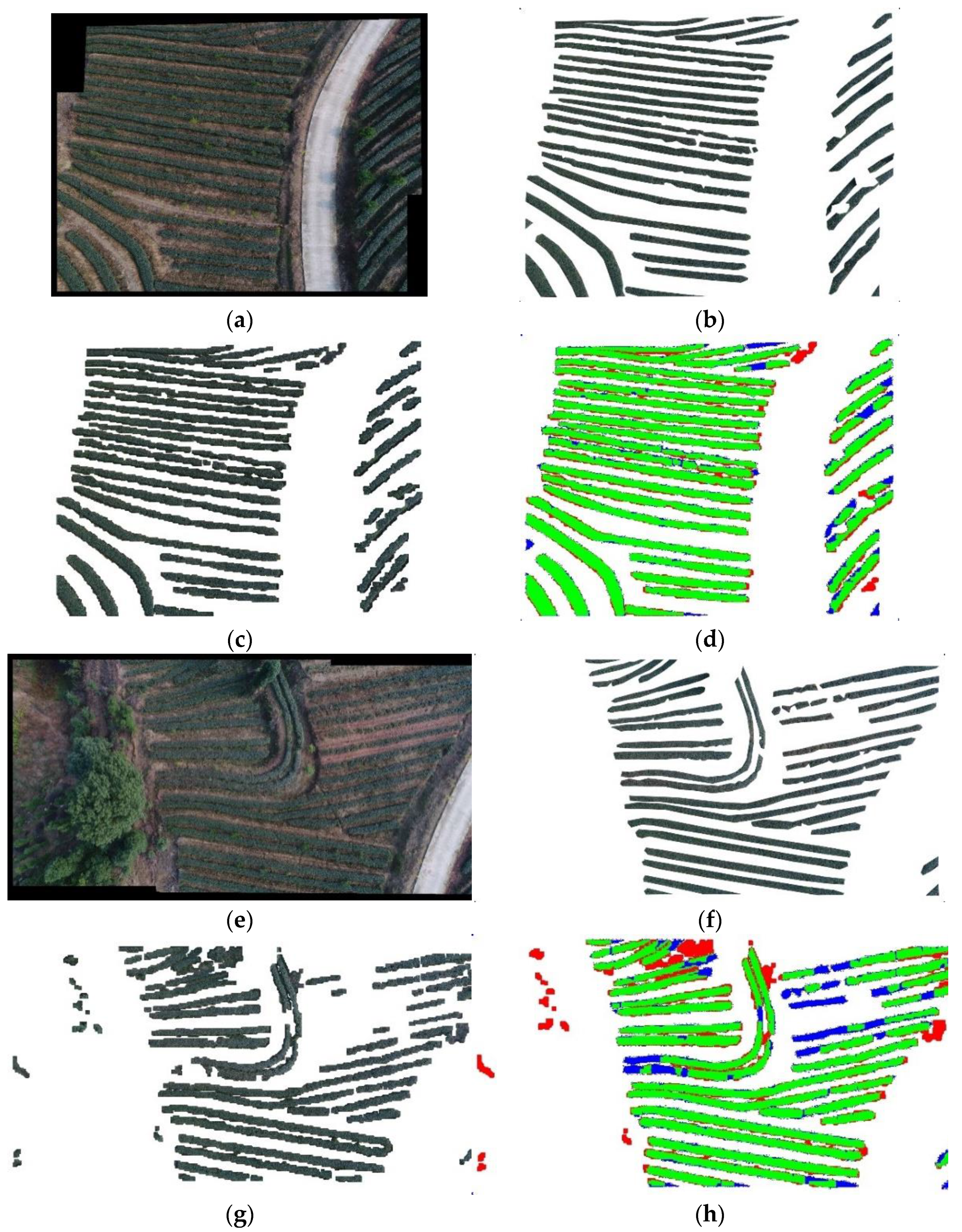
| Accuracy Rate | Error Rate | Omission Rate | IOU | |
|---|---|---|---|---|
| Group 1 (30 m high) | 84.91% | 15.09% | 8.63% | 78.61% |
| Group 2 (60 m high) | 91.24% | 8.76% | 11.87% | 81.26% |
| Group 3 (100 m high) | 93.28% | 6.72%% | 9.26% | 85.17% |
| Mosaic 1 (images for Group 1) | 84.96% | 15.04% | 10.62% | 77.17% |
| Mosaic 2 (images for Group 2) | 79.94% | 20.06% | 18.17% | 67.19% |
Publisher’s Note: MDPI stays neutral with regard to jurisdictional claims in published maps and institutional affiliations. |
© 2022 by the authors. Licensee MDPI, Basel, Switzerland. This article is an open access article distributed under the terms and conditions of the Creative Commons Attribution (CC BY) license (https://creativecommons.org/licenses/by/4.0/).
Share and Cite
Lu, J.; Xu, Y.; Gao, Z. An Improved Method of an Image Mosaic of a Tea Garden and Tea Tree Target Extraction. AgriEngineering 2022, 4, 231-254. https://doi.org/10.3390/agriengineering4010017
Lu J, Xu Y, Gao Z. An Improved Method of an Image Mosaic of a Tea Garden and Tea Tree Target Extraction. AgriEngineering. 2022; 4(1):231-254. https://doi.org/10.3390/agriengineering4010017
Chicago/Turabian StyleLu, Jinzhu, Yishan Xu, and Zongmei Gao. 2022. "An Improved Method of an Image Mosaic of a Tea Garden and Tea Tree Target Extraction" AgriEngineering 4, no. 1: 231-254. https://doi.org/10.3390/agriengineering4010017
APA StyleLu, J., Xu, Y., & Gao, Z. (2022). An Improved Method of an Image Mosaic of a Tea Garden and Tea Tree Target Extraction. AgriEngineering, 4(1), 231-254. https://doi.org/10.3390/agriengineering4010017






